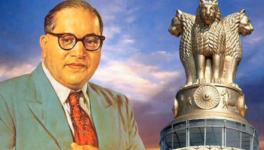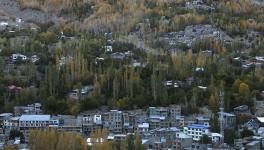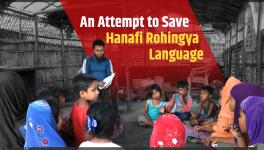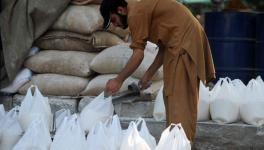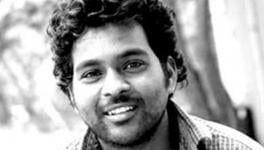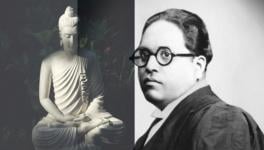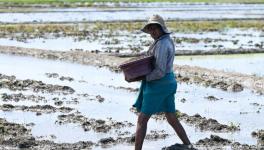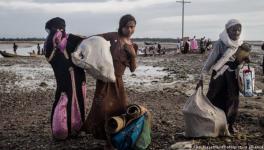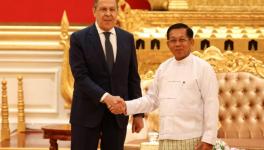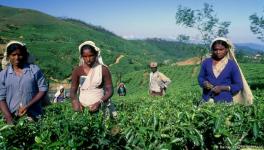The Monks Who Spew Hate

“Ordered disorder, planned caprice, And dehumanised humanity…”
- Bertolt Brecht in The Exception and the Rule (quoted in The Sunday Leader)
“I have done my duty towards the country,” Gnanasara told reporters as he boarded the bus taking him to prison. Why should I regret?”
Rarely does Sri Lanka convict Buddhist monks.
But few days back a court in Sri Lanka made history when it convicted Galagoda Aththe Gnanasara, the controversial leader of Bodu Bala Sena (Buddhist Power Force) who is referred to as 'Thero', The Venerable, and sent him to jail. Scores of his followers, mainly Buddhist monks, were reciting Buddhist prayers when he was being arrested and packed in to the police vehicle.
Reports tell us that Sri Lanka is still facing mini-turmoil over this conviction.
Marches were organised in different cities of Sri Lanka demanding that President pardons him using his special powers. Protesters have also asked that this revered monk should not be forced to wear jail uniform and be allowed to wear saffron robes only.
For people outside Sri Lanka, it would be rather difficult to understand why a Buddhist monk has suddenly become such a polarising figure in the society there.
Remember the courts found him guilty of intimidating the wife of a missing journalist Sandhya Eknaligoda inside the courts itself when he had interrupted a court hearing over the abduction of the journalist, Prageeth Eknaligoda, in which military intelligence officials were accused. He had shouted at the judge and lawyers because the military officials involved in the disappearance had not been allowed bail.
Public memory is very short but the abduction followed by disappearance of Prageeth had made international headlines. He had been investigating the alleged use of chemical weapons against civilians by Sri Lankan army in the fight against the Tamil rebels. It was perhaps a dark period as far as journalism in Sri Lanka was concerned when journalists were intimidated, made to disappear or even killed just for being critical of the then Rajapkshe led government's heavy handedness. Around a year before Prageeth's disappearance the murder of senior journalist Lasantha Wickrematunge by Army Intelligence people had also caused tremendous uproar.
"This is a government created by Sinhala Buddhists and it must remain Sinhala Buddhist. This is a Sinhala country, Sinhala government. Democratic and pluralistic values are killing the Sinhala race"[Al Maeena, Tariq A.; Neo-fascism on the rise in Sri Lanka; Gulf News; 23 February 2013]
He also told the crowd at the rally that they "must become an unofficial civilian police force against Muslim extremism. These so-called democrats are destroying the Sinhala race" [Bodu Bala Sena gives ultimatum to Ban Halal certification; Mirror; 18 February 2013]
No doubt Galagoda Aththe Gnanasara or TheroGnanasara is no ordinary monk.
With his latest smartphone, designer glasses and a chauffeur driven car, his look may be at variance with the time-honoured image of a Buddhist monk who survives in a meagre way, but by his intervention in the already fraught polity of this multireligious, multi-ethnic country he has emerged as an influential voice of Sinhala-Buddhist nationalism, which has always been an undercurrent in Sri Lanka. With suppression of Tamil militancy it has discovered 'new enemies' - the religious minorities - as its fresh targets. For it. Muslims (7.5%) are target number one but Hindus (15%), who are mainly Tamil speaking as well as the Christians (7.5%) are not far behind.
The surge in violence targetting Muslims, their properties and places of worship in March 2018, in district Kandy and adjoining areas, over a minor incident, which prompted President Maithripala Sirisena to declare an island-wide state of emergency was a fresh indication of the simmering tension.
For the likes of Gnanasara and his followers 'democratic and pluralistic values are killing the Sinhala race' and the minorities there should stick to the 'global principle that minorities must reside in a country in a manner that does not threaten the majority race and its identity.”
The demolition of a mosque near the Golden Temple of Dambulla - a Buddhist cave temple, famous since 3rd century, part of UNESCO world heritage site - with petrol bombs by a mob led by radical Buddhist monks in the year 2012, claiming that for them it was a 'sacred area' had signalled how things would unfold in a post Tamil militancy Sri Lanka. It was then rather disturbing to note that the government had also bowed to the mob’s demand and ordered the mosque’s demolition and relocation. It did not matter to the rampaging mob that not only the mosque but the temple as well as church there, were decades old and had been constructed on the land by taking valid permission from the concerned authorities.
It was only last year that Amnesty International had issued a strong statement focused on Bodu Bala Sena asking “Sri Lankan authorities to act immediately to end attacks on Muslims in the country, and to rein in violent groups that target religious minorities, and take action against perpetrators."
Providing details of violence and intimidation against Muslims, including petrol bomb and mob attacks on mosques, businesses and homes that have resulted in extensive property damage, and the failure of police to prevent these attacks, it had specifically mentioned the role of Buddhist monks associated with Bodu Bala Sena who "..[a]ttempted forcible land grabs in eastern Sri Lanka, and the media has reported a series of provocative and religiously charged speeches by BBS leader Gnanasara Thero."
It has said how Gnanasara Thero's hate speech vis-a-vis Muslim Rohingya refugees had created tension and how petrol bombs were thrown at a mosque when a BBS procession was stopped by police which was fourth attack on a mosque since mid-April. According to it, anti-Muslim violence in the town of Aluthgama claimed four lives and substantial property damage after speech by a BBS leader in June 2014.
The observations of a reporter who interviewed him in May 2018 were no different. He wrote: “Bodu Bala Sena leader Galagoda Aththe Gnanasara is a man whose words lead to action. When he threatens Muslims in a speech, mobs ransack Muslim neighbourhoods. And people die.
It would be important to watch how the whole issue of Thero Gnanasara's arrest unfolds: whether the present President Sirisena would succumb to the pressures being exerted by Sinhala-Buddhist Supremacists to release him or would he allow the law to take its course.
For him it is a rather difficult choice to make looking at the fact that the earlier President Mahinda Rajapakshe and his brother Gotobhaya had facilitated emergence of Bodu Bala Sena. When Mahinda Rajapakshe was still holding reins of power the country, Gotobhaya was the chief guest at the opening of the Buddhist Leadership Academy floated by Bodu Bala Sena and heaped praise on them for their "nationally important task".
Any such principled stand by President Sirisena can definitely damage him at the political level and benefit Rajapakshe whose party won big in the local elections held few months back.
And it would not be an exaggeration to say that it would have regional implications because the import of Gnanasara and his brand of politics is not limited to the island nation alone.
Words and actions of Galagoda Aththe Gnanasara can remind people of saffron robed monks/priests/Babas on this side of the border belching out similar hate speeches and calling for violence against the minorities here.
One can discover an eerie of similarity between how the Sinhala-Buddhists militants and the Hindutva Supremacists talk, act and think on similar lines. And much like them, there is hardly any action against them here.
Sinhala-Buddhists believe that they are part of the "Aryan Sinhala race", Sri Lanka is their home land, the mission of protecting Buddhism has been entrusted to them by Buddha himself and Sri Lanka is the home for Sinhala language while their Hindutva counterparts talk of making India a Hindu Rashtra and pushing the non-Hindus to a secondary status of citizenship. An ideologue of this vintage even writes in his book that they are the 'internal enemies' of independent India.
As one writer has put it:
An important feature of the Sinhalese that has influenced their attitude to minorities is that they are, as noted Sri Lankan anthropologist Stanley Tambiah described in his book Sri Lanka: Ethnic Fratricide and the Dismantling of Democracy, “a majority with a minority complex.” Thus although Sinhalese vastly exceed Tamils and Muslims in terms of numbers, they feel outnumbered by them. They see the island’s Tamils, for instance, as part of the larger Tamil community in the Indian state of Tamil Nadu and the Sri Lankan Muslims as part of the Muslim ummah.
This “minority complex” has resulted in Sinhalese viewing themselves as victims, who have to act, even violently, to defend the island and Sinhalese-Buddhist culture from being taken over by the asinhala (un-Sinhala) and abaudha (un-Buddhist). These groups are viewed as essentially “foreigners,” who are staying on the island due to Sinhalese-Buddhist sufferance.
If the Sinhala-Buddhists demand that the minorities in Sri Lanka should follow the 'global principle that minorities must reside in a country in a manner that does not threaten the majority race and its identity.” the proponents of Hindu Rashtra think on similar lines wherein they want to ensure that the minorities here should remain at the mercy of the majority or should adopt to Indian (read Hindu) ways.
While Sri Lanks celebrates its pluralism and India has formally adopted secularism as a core principle of the Constitution, one observes on ground that the response of the respective states to the overt and covert violence against the minorities, leaves much to be desired. There are reports galore which show how the state has looked the other way when religious minorities of various dispensation have come under attack or has even connived with the majoritarians and denied the minorities justice.
While the world at large could easily look through what BBS stands for and how it's increasing clout would impact negatively in a multi-ethnic, multi-religious, multi-lingual country which was trying to establish peace and reconciliation after culmination of a long drawn civil war against Tamil militants, the reaction of Ram Madhav, an RSS leader, who is now a key leader of the BJP, was baffling :
"Bodu Bala Sena - a Buddhist organisation many wish to call as Right or Ultra-Right – is a new phenomenon in Sri Lanka. One may prefer to brand them in any manner one would like to. But the fact remains that this new outfit is slowly growing in stature and popular support in the country’s Buddhist-dominated areas."
..."the issues raked up by the BBS are worthy of active and sympathetic consideration. BBS is able to capture the attention of the Buddhist population of Sri Lanka. "
It is possible that the way BBS had framed its world view - about 'growing Islamisation and Christianisation of the Island nation' - had stuck a chord with the then Akhil Bharatiya Sah Sampark Pramukhof RSS before he shifted to BJP.
It was no mere quid pro quothat when BJP assumed power on its own in 2014, Dilantha Withanage, chief executive of Bodu Bala Sena (BBS) and close associate of Galagoda Aththe Gnanasara, had supposedly returned the compliments. Claiming that Bodu Bala Sena "is inspired by what the RSS and BJP do in India” and had also underlined the similarities in the situation existing in both the countries "“There are lots of similarities between India and Sri Lanka,” Withanage said. “Both of us face threats from Muslims and minorities who are actively engaged in conversions. When Sinhalese families have a child or two, minorities have half a dozen or more. When foreign money plays behind such activities, we need to resist. So Modi and his party is a great inspiration for us,”
The reporter who had filed this report had rightly commented "This is one overseas fan base that Prime Minister Narendra Modi and his party BJP would not wish to flaunt.”
The rise of Sinhala-Buddhist Supremacism in our neighbouring country and the ascent of Hindutva here around same time cannot be considered an exception at least in this part of South Asia where majoritarian voices/forces owing allegiance to a particular religion or ethnicity are either gaining strength or consolidating themselves.
The growing Saudisation of Pakistan or the rise of Islamist forces/organisations in neighbouring Bangladesh underlines how such voices have taken shape there, basing themselves on the constructed 'anxieties of the majority community'. Pakistan seems to be bursting at its seams where various fanatic groups with their violent acts against the ‘others’ – ranging from the Ahmadiyas, Shias, Hazaras, Hindus etc – have created a situation of implosion.
The recent killing of Shahzahan Bachchu, owner of Bishaka Prokashoni, a publishing house, who was gunned down in his home town in Munshiganj once again brought to the fore the clout Islamists hold in formally secular Bangladesh. It is true that because of a strong tradition of secular movement, situation seems to be still under formal control of such forces in Bangladesh (of course, it is not a great consolation) but that has not stopped it from penetrating deep into the pores of society there.
Few years back when a mass movement had arisen in Bangladesh demanding punishment for the War Crimes committed during the liberation war (1971) - where the focus was on the Islamists led by Jamaat-e-Islami who had collaborated with the Pakistani army - a study was published in Mainstream (Mar 22-28, 2013) which had elaborated upon the political economy of fundamentalism. It is an issue about which not much material is available also. According to Prof Abdul Barkat’s unique study, who was then with Dept of Economics, Dhaka University and President of Bangladesh Economic Association:
..[f]undamentalists have created an “economy within the economy” and “a state within the state” They have adequate economic strength (from micro to macro levels) to sustain their political organisations. The economics of fundamentalism, in the narrow sense of the term, can be explained in terms of enterprises ranging from large financial institutions to household level micro credit, from mosques and madrassas to news media and IT, from nationwide trading enterprises to local level NGOs. The estimated amount of annual net profit generated by these enterprises would be US $ 250 million. All these economic enterprises are run by ideologically motivated and professionally competent persons. At least 10 per cent of their net profits are being used to finance the political organisation, which is sufficient to fund the salary of 500,000 full-timers in Islamic fundamentalist politics. The relative strength of the economics of fundamentalism in Bangladesh can be traced to the fact that its annual net profit is equivalent to six per cent of the government’s annual development budget and the annual growth rate of the economy controlled by the fundamentalists is higher (7.5 per cent to nine per cent) than that of the national economy (five to six per cent).
Discussing how fundamentalism was experimenting the effectiveness of various politico-economic models with the help of cadre based politics, he had discussed how the following twelve, constitute the key sectoral elements of the model : “financial institutions, educational institutions, pharmaceutical-diagnostic and health related institutions, religious organisations, transport related organisations, real estate, news media and IT, local government, NGOs, Bangla Bhai or JMB, Jamaetul Muzahideen Bangladesh, Harkat-ul-Jihad-al-Islami (Bangladesh HuJi-B) (and such programme based organisations), and occupational/professional activity based organisations including of farmers and industrial workers.”
According to him
The estimated annual net profit of economic fundamentalism in Bangladesh would be about US $250 million. The highest share of such profit, 27 per cent (of the total net profit), comes from financial institutions (banks, insurance companies, leasing companies, etc.
The second highest, 18.8 per cent of the total net profit, comes from NGOs, trusts and foundations, 10.8 per cent comes from trading concerns, 10.4 per cent profit comes from the pharmaceutical industry and health institutions including diagnostic centres, 9.2 per cent comes from educational institutions, 8.5 per cent comes from real estate business, 7.8 per cent comes from the media and IT business, and 7.5 per cent comes from the transport sector
Explaining the methodology of estimation, Prof Barkat had made it clear that it is largely based on heuristic estimates, but the pattern was indicative of the direction.
It can be observed that the rise of the politics and economics of fundamentalism in Bangladesh has led to institutionalisation of fundamentalism which implies organised penetration of Islamist fundamentalist forces in all key spheres of life and state operation. In fact, the relative strength of this institutionalised fundamentalism is also evident in formation and operation of Islamic Sharia Council against the usual norm of the Central Bank. Prof Barkat adds that this
“Islamic Sharia Council - the central policy making body of all Islamic financial institutions - is a body fully controlled by the mainstream Islamist Party (Jamaat-e-Islami in this case) and headed by the Pesh Imam (the head) of the National Mosque, who is a government servant, who preaches in favour of implementation of Sharia rule through the mosque based administration and judiciary. This Islamic Shariah Council is an illegal entity according to the Company Act and Banking Act operating in Bangladesh. The Central Bank’s attempts to ban this Islamic Shariah Council and even the move to institute a “guideline for Islamic Banking” in Bangladesh could not be materialised in the past. And finally, an attempt to pass a law in the parliament “against religious extremism” ended up in gross failure.”
There was a period in the first part of the 20th Century when the people in this part of South Asia, then under colonial subjugation, had fought against the Britishers in their own way and gained political independence. It has been more than 70 years that they achieved freedom but today they are confronted with an altogether different challenge.
If one digs further one can as well trace the roots of this situation in the way the anti-colonial struggle was fought or how the tensions arising from the internal asymmetries and fissures in the respective societies could not be properly addressed. No doubt, it is a very precarious situation and if it is not handled properly, the whole region can become a tinderbox of sorts.
One can even discern a pattern in the rise of Sinhala-Buddhist nationalism in Sri Lanka, ascent of Hindutva Supremacism in India or Political Islam taking its strides in Pakistan as well as Bangladesh.
What is noticeable in this picture is that
- perpetrator community changes as you cross the national borders. In fact, one finds a reversal of roles. Perpetrator community on this side of the border metamorphoses into victim community on the other side of the border
- One type of fanaticism feeds on the other. And there are reports that different types of alliances are coming up between them
Situation unfolding in neighbouring Mynamar, explains how this alliance building of sorts between various exclusivist/sectarian ideologies/formations is taking shape.
Mynamar, as everybody knows is making headlines the world over because of the plight of Rohingya Muslims, which is developing since last few years. Many reports have appeared detailing the role played by the army in the ethnic cleansing of the hapless citizens, burning down of their villages and the silence maintained by the likes of Aung San Su Kyi.
And here also the role of saffron robed Buddhist monks has come under scanner, who have been accused of making hate speeches targetting Muslims, instigating riots, etc. For example, Thitagu, a prominent abbot (head of monks) had in an interview said that “In ethnically diverse Burma, members of different religions should live together like water flowing together” and in the same interview he warned that “just like the Buddhist host has warmly welcomed other faiths into the country, the guests should strive to get along with the host. They should not trespass on the host’s goodwill and take over the home”. Of course, the most controversial among them is Wirathu . ‘Guardian’ had done a special story on him few years back who with his 2,500 follower monks has become a dreaded name in the country, instigating Buddhist fanatics to attack Muslims.
Attempts to coordinate activities against a ‘common enemy’ had received a boost when the infamous Wirathu visited Sri Lanka and a proposal was put forward by Wirathu and BBS jointly seeking Hindutva Supremacists nod to form what they called a “Peace Zone”:
..The time has come to ally internationally,” Galagodaththe Gnanasara, the leader of the radical Sri Lankan Buddhist group Bodu Bala Sena, announced at a convention held in Colombo last month. The guest of honor was Ashin Wirathu, a Buddhist radical whose picture Time magazine put on its July 1 cover as “The Face of Buddhist Terror.” The government of Prime Minister Mahinda Rajapaksa ignored pleas by Sri Lankan Muslim and Christian civil groups, fearful of more anti-Muslim violence in their country, to deny Mr. Wirathu a visa. Granting Mr. Wirathu a visa can only reinforce the fears of many Muslims that the government — and perhaps more powerful regional allies — back Bodu Bala Sena, which translates as Buddhist Power Force.
Last week, Mr. Gnanasara claimed he was in discussions “at a high level” with the right-wing Indian Hindu group Rashtriya Swayam Sevak to form what he called a “Hindu-Buddhist peace zone” in South Asia. A Rashtriya Swayam Sevak spokesman, Ram Madhav, promptly denied that there were any such discussions. But Mr. Madhav, now general secretary of India’s governing Bharatiya Janata Party, has written comments sympathetic to Bodu Bala Sena and Mr. Wirathu’s group 969 in Myanmar on his Facebook and Twitter accounts.
The plight of Rohingya Muslims has become a cause of international concern. The military in Mynamar has provided tacit support to their ethnic cleansing of the hapless minority.
What is rather disturbing to note that when PM Modi visited Myanamar last year the joint statement he and Myanmar’s State Counsellor and de facto leader, Aung San Suu Kyi issued remained silent on the mass cleansing of the Rohingyas but expressed grave concern on the ‘terrorist’ activities of a section of Rohingyas in self-defence. It read:
“It is important to maintain security and stability along the long land and maritime borders of India and Myanmar...India stands with Myanmar over the issue of violence in the Rakhine state which has led to loss of innocent lives.”
In his article "Genocide of Rohingyas in Myanmar: the Hindutva Imprints" commenting on this trip Prof Shamsul Islam underlined
"This statement remained silent on the mass cleansing of the Rohingyas but expressed grave concern on the ‘terrorist’ activities of a section of Rohingyas in self-defence. In a more shocking development the RSS/BJP Indian Government has issued instructions to deport nearly 40,000 Rohingyas, who escaped to India while under attack, for being a security threat.
How does one understand this silence?
As the dictum goes: Silence speaks and, in this case, also should we say that the silence of the Indian rulers over the mass cleansing of Rohingyas spoke a lot.
Forget Rohingyas. And the Indian rulers for a moment.
Why did the conviction of Thero Galagoda Aththe Gnanasara not become news here?
Rarely does Sri Lanka convicts monks but when judicial history of sorts was made in the neighbouring country why did the media here keep mum?
Get the latest reports & analysis with people's perspective on Protests, movements & deep analytical videos, discussions of the current affairs in your Telegram app. Subscribe to NewsClick's Telegram channel & get Real-Time updates on stories, as they get published on our website.









